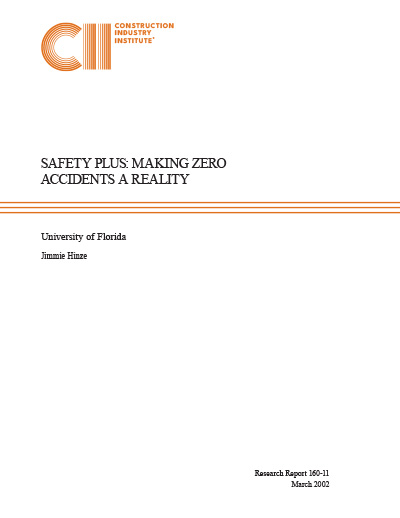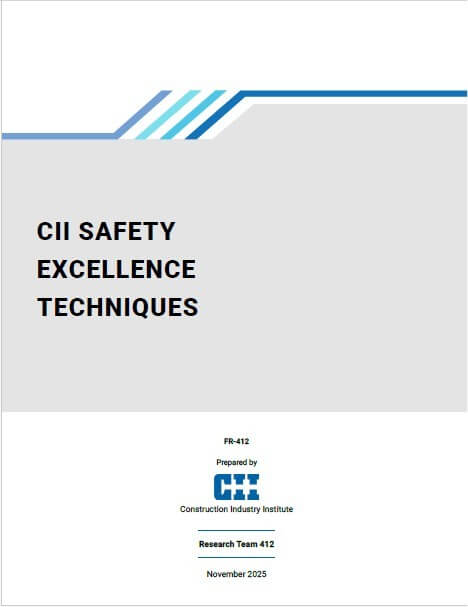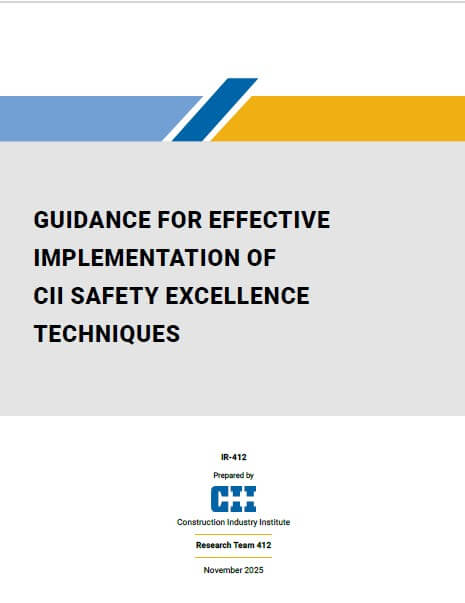
Safety Plus: Making Zero Accidents A Reality
This research effort was a follow-on effort to the zero accidents work that was sponsored by the CII in the early 1990s. It was apparent that changes had taken place in how safety was being addressed by many of the progressive or pro-active construction firms. This research study was undertaken to identify the current best practices in the construction industry that make a difference in safety performance and that move the industry toward the goal of zero accidents. Information was obtained by conducting two different studies. One study consisted of 106 replies obtained in a nationwide mailed survey that was sent to the largest 400 construction contractors. The second study consisted of 38 personal interviews conducted on large North American construction projects. The results of these two studies are presented in separate chapters.
This research effort identified nine key topic areas that contribute to improved safety performance. The five high impact areas that were noted in the first zero accident report are among these nine, but there are some notable differences in how these are now being implemented. The nine key topic areas to achieve world-class safety performance are noted as follows:
- Management Commitment
- Staffing for safety
- Planning: pre-project and pre-task
- Safety education: orientation and specialized training
- Worker involvement
- Evaluation and recognition/reward
- Subcontract management
- Accident/incident investigations
- Drug and alcohol testing
These topic areas are presented in order of how the development of a safety initiative might take place. There is no attempt to prioritize them. The project team suggests that these initiatives be taken as a consolidated group. There is no “silver bullet” in that good safety performance cannot be achieved with only one of the topic areas being implemented. Of course, it is readily agreed that management commitment is perhaps of paramount importance.
Management commitment for safety is essential to convey to others in the firm that costs, schedule, and quality do not take priority over safety. This can be demonstrated in a variety of ways. The circumstances may dictate those means that are perhaps most feasible. The commitment must be sincere and it must somehow be conveyed to the worker level. Without this clear communication, safety performance will very likely be compromised.
Staffing for safety is essential on large projects. It requires full-time safety personnel to ensure that the safety needs of the projects are being satisfied. Additional safety personnel will be required when the number of workers is increased. These safety personnel form the core of the training program on the project and they will provide the day-to-day safety support for the field personnel.
Pre-project and pre-task planning continue to play a vital role in jobsite safety. Site specific safety programs ensure that the projects have a safe start and the pre-task safety plans ensure that the daily tasks are performed with safety integrated into the daily work routine.
Safety education is a major component of jobsite safety. The training and education of workers should begin with formal jobsite orientation of every worker. As is true in most settings, the learning process is never completed. As time goes by and as jobsite conditions change, it is necessary to provide additional training to workers. This training tends to be focused on the needs of individuals, whether they are field workers, supervisors, or managers.
Worker involvement is perhaps the area in which the most significant changes have taken place in recent years. This is essentially based on the view that workers are not just a valuable resource to be protected but also a resource that can contribute to achieving the goal of zero accidents. Such involvement can be achieved through several means, including observations of worker behavior, input through worker safety perception surveys, and by worker participation on safety committees.
Worker evaluations and recognition/reward programs have shown some success in improving safety performances. While the traditional incentive programs offer no assurance of good safety performance, some techniques were noted to offer guidance. If incentives are offered, for example, they need not be costly, they should be given often, and they should be based on a specific goal. Good safety performance should also influence evaluations that may directly impact wage increases.
Subcontract management implies that the safety agenda of the general contractor must extent beyond its own employees. If the safety program is to be effective, it must involve the subcontractors whereby they are included in the orientation training, the drug testing, the safety planning, etc.
Accident/incident investigations must be conducted diligently to identify the root causes. Near misses are now included in those events that are to be investigated. These near misses are to be regarded as inexpensive "wake-up calls" that may be instrumental and very valuable in avoiding costly injuries.
Drug and alcohol testing continues to reveal its importance to the achievement of good safety performance. Rehabilitation is currently not widely employed in the industry but may be an area to be given consideration in the future.
By employing the nine key topic areas of safety achievement, firms can be expected to realize significant savings through the reduction of injuries. The cost of investing in a solid safety program will pay off handsomely through the substantial reduction realized in the costs attributed to injuries.



